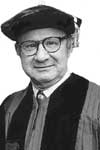Palevsky, Legorreta to join University May 14 to dedicate new student residential commons
By Peter SchulerNews Office
 Ricardo Legorreta |
“Having lived in it, seen it in functional terms and gotten to know it, we now appreciate what is pleasant and indeed wonderful about this building. And there’s no question that the students love it,” said Martin Stokes, Associate Professor in Music and the College, who, with his wife, Lucy Baxandall, a teacher at the K.A.M. Isaiah-Israel Nursery School, has completed a third quarter as a Resident Master for the new Max Palevsky Residential Commons.
With their two children, they share a fourth-floor apartment in Palevsky East, one of the three structures that compose the Commons along with Palevsky Central and Palevsky West.
Palevsky resident Ashraf Husain, a first-year in the College, said the architecture of his new home harmonizes with the rigor of students’ academic experiences at the University.
“The structure of the building, where the inward facing rooms look into other inward facing rooms, is a great comfort, especially when other lights are still on in the wee hours of the morning. Observing the similarities among the residents ties us together and helps create unique friendships when we know that we’re all in the same boat.”
 Max Palevsky |
The striking, three-part building, with its vibrant colors, abundant light, multiple interior courtyards, sleek hallways and long sight lines, is now home to 724 students. The Palevsky Residential Commons creates a new campus quadrangle, which includes the Bartlett Dining Commons and the Joseph Regenstein Library. Final construction work and landscaping will be completed soon.
The celebrated Mexican architect Ricardo Legorreta, who designed Palevsky Residential Commons, will join alumnus and philanthropist Max Palevsky (A.B., ’48) at a Tuesday, May 14 dedication ceremony. Palevsky, who studied mathematics and philosophy at the University, donated $20 million toward the $54.6 million residential building project.
Stokes said Palevsky Commons is an appropriate addition to a campus filled with strong, risk-taking architectural statements. “Living here, walking in the bright corridors, enjoying the vistas and the dramatic internal angles––this is definitely a building that one understands and appreciates even more from the inside out,” he added.
“Our idea of what a university looks like was formed for both of us at Oxford, where we lived in a college built in the 16th century,” Stokes said. “And we’ve never lived in a building as new as this.”
 Max Palevsky, who gave the University $20 million to help fund the new Max Palevsky Residential Commons at 56th Street, between Ellis and University avenues, will visit the residence halls and attend a dedication ceremony for the new building. Palevsky will be joined by noted Mexican architect Ricardo Legorreta, who designed the building, and Legorreta’s son and partner, Victor. Directly above is a photo taken in Palevsky East, which shows the interior of a room in the new residence halls. |
Stokes and Baxandall, like all other Resident Masters, frequently welcome student residents into their own apartment for such gatherings as dinners, Sunday brunches, evening conversations with invited scholars and meetings to keep the eight houses of Palevsky Commons running in sync. They give substantial credit for the success of Palevsky’s first year to the dedication of their eight resident heads, as well as to Ana Campos, Assistant Director of the University House System, who also lives in Palevsky with her family.
“It’s been a very interesting year,” Baxandall said. Shortly after the first students moved into the building came the traumatic events of Tuesday, Sept. 11. The residents in Palevsky Commons include many Muslim students, observant Jewish students and significant international representation. “Parents letting go of their children when they head off to college is always difficult,” Baxandall said, “but this was a particularly stressful time. We felt it was critical to make everyone feel at home here and as secure as possible.”
With the closing and demolition of Woodward Court to make way for the new Graduate School of Business complex, students from Woodward Court made a mid-year transition to a new home. “It is the double-edged sword of a house system,” Baxandall said. “Its strength is to encourage people to develop a distinct identity, which makes changing that identity difficult.” At the same time, construction on the Central and West buildings of Palevsky was still in progress. “All things considered, I think our first year as a community has worked out remarkably well,” Baxandall said.
![[Chronicle]](/images/small-header.gif)